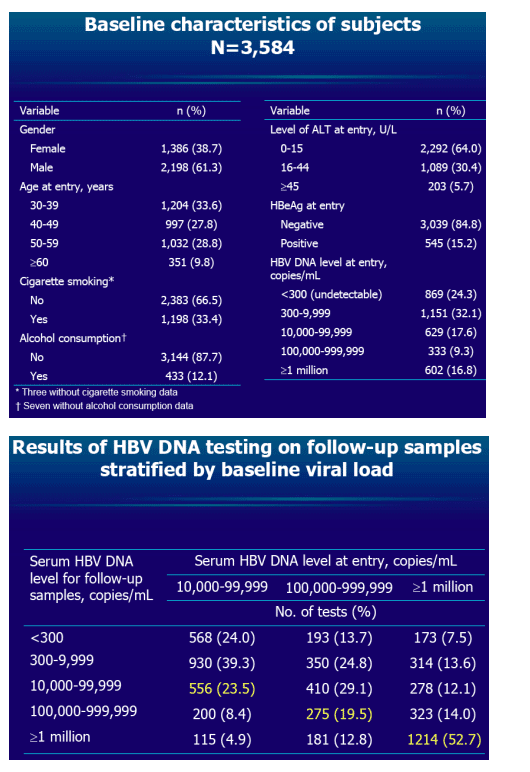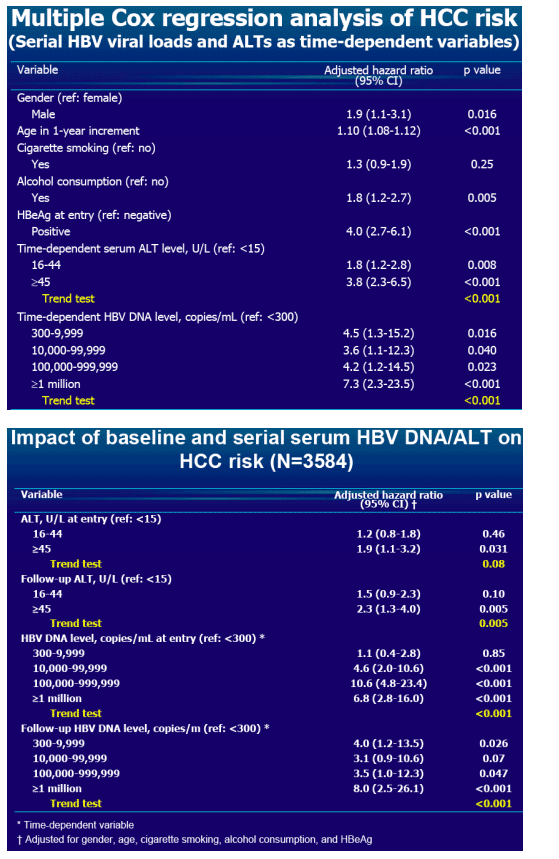 |
 |
 |
| |
Increasing HBV Viral Load Increases Risk for Liver Cancer--Serial Monitoring of Viral load and Serum Alanine Aminotransferase (ALT) Level and the Risk of Hepatocellular Carcinoma: R.E.V.E.A.L- HBV Study Update
|
| |
| |
Reported by Jules Levin
43rd EASL Conference
April 23-27, 2008
Milan, Italy
C.J. Chen1,2, H.I. Yang1,2, J. Su3, C.L. Jen1,2, S.L. You1,2, C.F. Chen1,2, U.H. Iloeje4
1 Genomics Research Center, Academia Sinica, Taipei, Taiwan;
2 Graduate Institute Of Epidemiology, College Of Public Health, National Taiwan University, Taipei, Taiwan;
3 Global Epidemiology And Outcomes Research, Research And Development,
Bristol-Myers Squibb Company, Wallingford, CT, USA;
4 Global Clinical Research, Research And Development, Bristol-Myers Squibb Company, Wallingford, CT, USA
AUTHOR SUMMARY
In the subset of the REVEAL study cohort with baseline HBV DNA ≥104 (10,000) copies/mL, no evidence of liver cirrhosis at entry, anti-HCV-negative and ≥2 frozen serum samples available for HBV DNA testing
-Risk of developing HCC was strongly associated with increasing HBV DNA
Hazard ratio was fourfold greater for individuals with HBV DNA of 300 to <10^4 (10,000) copies/mL and were 6 fold greater for individuals with HBV DNA ≥104copies/mL (>10,000) when compared with those who spontaneously achieved an undetectable HBV DNA level (<300 copies/mL)

-Chronically elevated serum ALT level was also an important predictor of HCC development
AUTHOR CONCLUSIONS
These updated analyses confirm the findings of our original analyses
Increasing HBV DNA level remains a very significant predictor of HCC after taking follow-up HBV DNA and change in serum ALT into account
-This is independent of other viral and host factors such as HBeAg status, age and gender
The persistence of high HBV load leads to the highest HCC risk. Long-term monitoring of HBV viral load is essential for the management of CHB
INTRODUCTION
The risk of liver disease progression in Chronic Hepatitis B (CHB) is linked to several viral, biochemical and immunological markers
In our published analyses,1-3baseline serum HBV DNA was the most important predictor of liver cirrhosis, Hepatocellular Carcinoma (HCC) and liver-related death
In these previous reports
-Participants with baseline cirrhosis were included
-HBV DNA and ALT in serial follow-up samples were not analyzed
This study aimed to evaluate HCC risk using complete data on serial ALT and HBV viral load
1. IloejeUH, et al. Gastroenterology. 2006;130:678-86.
2. Chen CJ, et al. JAMA. 2006;295:65-73.
3. IloejeUH, et al. ClinGastroenterolHepatol. 2007;5:921-31.
METHODS
The R.E.V.E.A.L.-HBV study is a population-based prospective cohort study with a mean follow-up of 11.4 years, as described in the previous publication1
A subgroup of this cohort was included in this study (HBsAg seropositive and anti-HCV-seronegative, without liver cirrhosis at entry)
-Serial HBV DNA analyses were conducted only for subjects with HBV DNA ≥104 copies/mL (10,000 c/ml) at study entry (N=1,564; HBV DNA samples=7,644)
-Only baseline data from the other 2,020 participants with HBV DNA <104copies/mL (10,000) at entry were used
1. Chen CJ, et al. JAMA 2006; 295:65-73
Laboratory tests
-HBsAg and HBeAg by radioimmunoassay (Abbott Laboratories, North Chicago, IL)
-Anti-HCV by second-generation ELISA kits (Abbott Laboratories)
-ALT by serum chemistry autoanalyzer (Model 736, Hitachi Co., Tokyo, Japan) using commercial reagents (bioMrieux, Marcy lĠEtoile, France)
-Serum HBV DNA level by Cobas Amplicor (Roche Diagnostics, Indianapolis, IN) for baseline and last follow-up samples
HBV DNA test kit upgraded since initial analyses to CobasTaqmanHBV test kit (Roche Diagnostics) for other follow-up samples
HCC cases were ascertained by computerised data linkage to the National Cancer Registry and Death Certification System in Taiwan
All HCC cases were confirmed based on the following criteria:
-Histopathology
-Two positive coincident image techniques (abdominal ultrasonography, angiogram or computed tomography)
-One positive image technique with an elevated serum _-fetoprotein level >400 ng/mL
Time-dependent Cox models were used to estimate multivariate-adjusted hazard ratios
-Entry serum HBV DNA and ALT levels were treated as time-independent and
-dependent variables in separate models
-Follow-up serum HBV DNA and ALT levels were modelled as time-dependent variables, in which all viral loads and ALT levels of participants were included to assess their effects on HCC
-Multivariate-adjusted hazard ratios (HRadj) of developing HCC and 95% confidence intervals (CI) were estimated separately for time-independent and
-dependent variables
RESULTS



|
| |
|
 |
 |
|
|